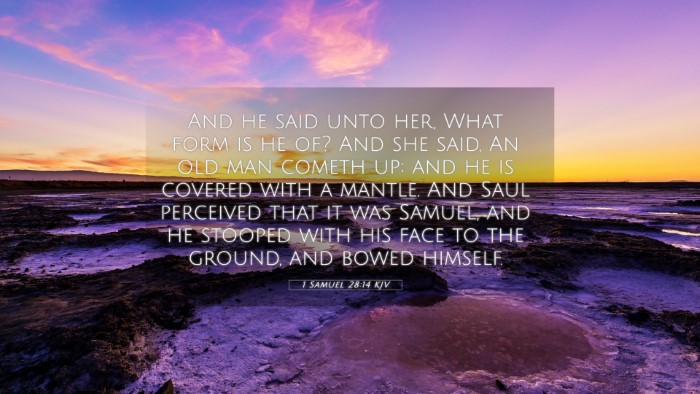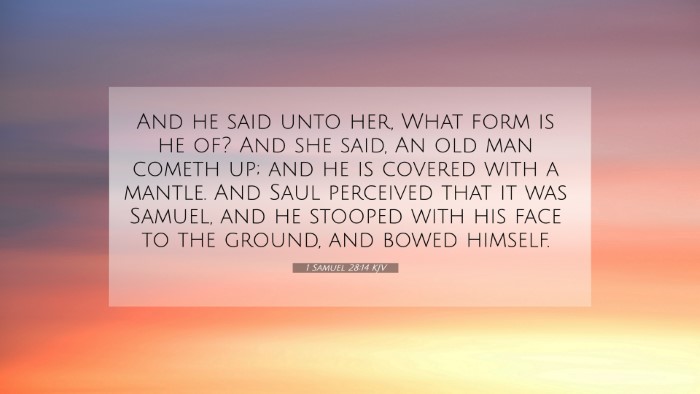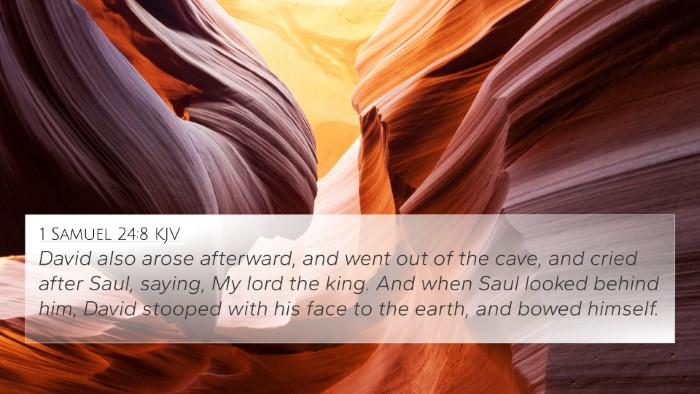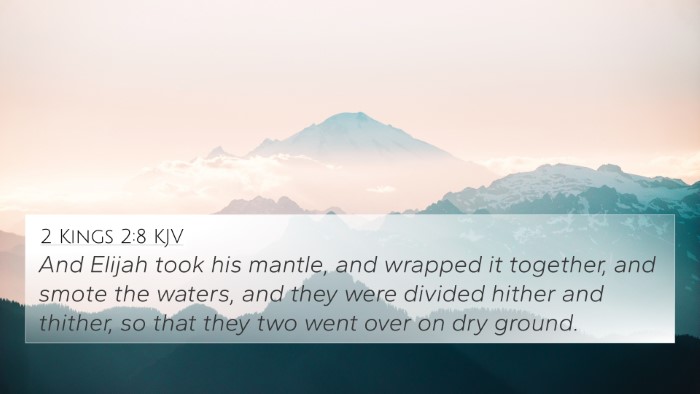Understanding 1 Samuel 28:14
1 Samuel 28:14 states:
"And he said unto her, What shape is he of? And she said, An old man cometh up; and he is covered with a mantle. And Saul perceived that it was Samuel, and he stooped with his face to the ground, and bowed himself."
Meaning and Interpretation
This verse describes a pivotal moment in the narrative of Saul, the first king of Israel. In his desperation, Saul seeks out the witch of Endor to summon the prophet Samuel's spirit for guidance. This moment underscores the tragic decline of Saul's faith and the consequences of turning away from God.
Commentary Insights
Based on insights from public domain commentaries including Matthew Henry, Albert Barnes, and Adam Clarke, several key themes emerge:
- Desperation: Saul's actions reveal a deep sense of despair and isolation. His rejection by God, as noted in previous chapters, leads him to consult a medium, which the Law of Moses explicitly forbids.
- Recognition of Authority: The description of Samuel as an "old man" suggests his wisdom and prophetic authority. Saul’s physical gesture of bowing down signifies his recognition of Samuel’s divine role.
- Revelation of Sin: This encounter exposes Saul's sin of seeking guidance outside of God. The commentary highlights this as a warning against turning to occult practices.
Bible Verse Cross-References
1 Samuel 28:14 connects to several other verses in Scripture, illustrating the broader biblical narrative:
- Deuteronomy 18:10-12: This passage warns against necromancers and mediums, emphasizing the covenantal restrictions on seeking unholy guidance.
- 1 Chronicles 10:13-14: These verses provide an account of Saul's downfall due to his disobedience to God, culminating in his consultation with the witch.
- 1 Samuel 15:23: Samuel previously told Saul that rebellion is as the sin of witchcraft, foreshadowing Saul’s eventual path.
- Isaiah 8:19: This verse cautions against consulting the dead or the spirit world for guidance, aligning with the context of Saul's actions.
- Luke 16:31: In the New Testament, this verse speaks to the finality of the consequences of one's choices, particularly regarding faith and responses to divine messages.
- Job 26:5: This passage reflects on the spirits of the dead and the spiritual realm, underlining the serious implications of contacting them.
- Galatians 5:20: The mention of witchcraft as a work of the flesh continues the theme of spiritual disobedience found in Saul’s actions.
Connections Between Bible Verses
Examining 1 Samuel 28:14 and its cross-references can yield deeper insights into biblical themes:
- Faith vs. Despair: Saul's lack of faith leads him to seek answers from the dead, contrasting with the faithful approach of seeking God.
- Divine Authority: The reverence shown to Samuel reflects the overarching biblical emphasis on respecting God's appointed leaders and prophets.
- Consequences of Sin: The cumulative narrative reveals that turning away from God's ways has profound spiritual ramifications, illustrated through Saul's tragic story.
Comparative Bible Verse Analysis
In conducting a comparative analysis, we can observe various parallels:
- Saul and King Manasseh: Both kings exemplify disobedience and idolatry, facing severe consequences for their actions.
- Prophetic Voices: While Saul seeks guidance from a medium, other biblical figures—like Samuel and the prophets—explicitly call upon God's will.
Thematic Bible Verse Connections
Several themes emerge from exploring this text:
- Divine Judgment: God's judgment upon Saul is evident as he faces the dire consequences of disregarding divine commands.
- Hope and Despair: The contrast of faithfulness to God versus the despair that leads individuals away from divine guidance is a recurring theme throughout Scripture.
Conclusion
1 Samuel 28:14 invites readers to reflect on the dire consequences of turning away from God and seeking guidance from unholy sources. Through cross-referencing and thematic connections with other biblical texts, the complexity of Saul's character and his spiritual decline is better understood. For anyone engaged in a study of the Bible, using tools for Bible cross-referencing can yield rich insights into the intricate relationships between different verses and themes within Scripture.






